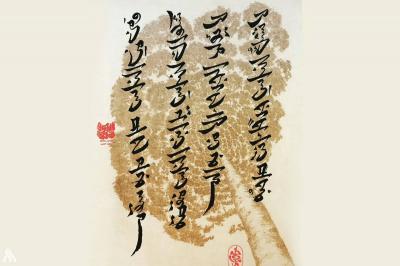The young Iraqi artist Taha Dukhan has filled his life with a passion for the art of lettering and transforming words into artistic masterpieces since his childhood. He discovered his unique ability to turn letters into works of art, realizing from the beginning that he had a promising future in the world of calligraphy. Today, Dukhan has shone by creating a new script that combines Arabic and Asian elements, adding it to the list of hybrid Arabic scripts.
Dukhan, who loves calligraphy in all its forms, confirms that he followed his teacher's instructions in arts education when she asked him to imitate different calligraphic styles. He says in a conversation with the Iraqi News Agency (INA): "The school is where I was discovered, as my teacher asked me to replicate artworks in Fatimid Kufic script. When I drew them, I did not know how this art worked; I was just drawing what I saw and considered beautiful."
Initially, Taha faced difficulties while experimenting to refine the script and establish rules that could be followed, allowing the calligrapher to work on it for clearer presentation. He clarifies that he had never visited Japan or China, nor did he learn their languages since they write with brushes. However, Taha invested hours researching in his own way. He adds, "I have knowledge of all types of Arabic scripts, and over time, I became proficient in all of them."
In his early days, he used all available tools such as pencils and ink, but as he progressed, he had to purchase specific tools for Arabic calligraphy and eventually started making them himself at home, using ink, paper, and pens, until everything in his room was related to calligraphy, all made by him.
The blending of cultures caught Taha's attention with the strange shape of Chinese or Japanese script, and he wanted to merge East Asian and Arabic cultures together. He began designing this script after a long time, stating to the Iraqi News Agency (INA): "The idea had been forming in my mind since early 2015 after joining the Iraqi Calligraphers Association, and I started executing the letters in mid-2017 before officially launching the script in 2019."
Dukhan clarifies that to complete his script, he communicated with Japanese and Chinese artists through social media, learning from them how to write their words and characters. The script was named "Nihon Arabic," derived from two syllables, where "Nihon" means "Japan" in Japanese. He took the first syllable "Niho" without the letter "n" to match the pronunciation that follows, "Arabic." Thus, its meaning is "Japanese Arabic script" (Nihon Arabic).
Dukhan sees one of the advantages of this script as inspiring the viewer to perceive it as Japanese or Chinese; however, upon closer inspection, it becomes clear that it has been written in Arabic letters. He explains, "The first word I wrote was 'freedom' in Nihon Arabic, expressing the freedom I found in this new script."
Mohammad illustrates that "Taha managed to blend two entirely different civilizations—Arabic and Japanese—into one word, which is not easy to unify, but he accomplished this through language, making the word a bridge connecting two worlds."




